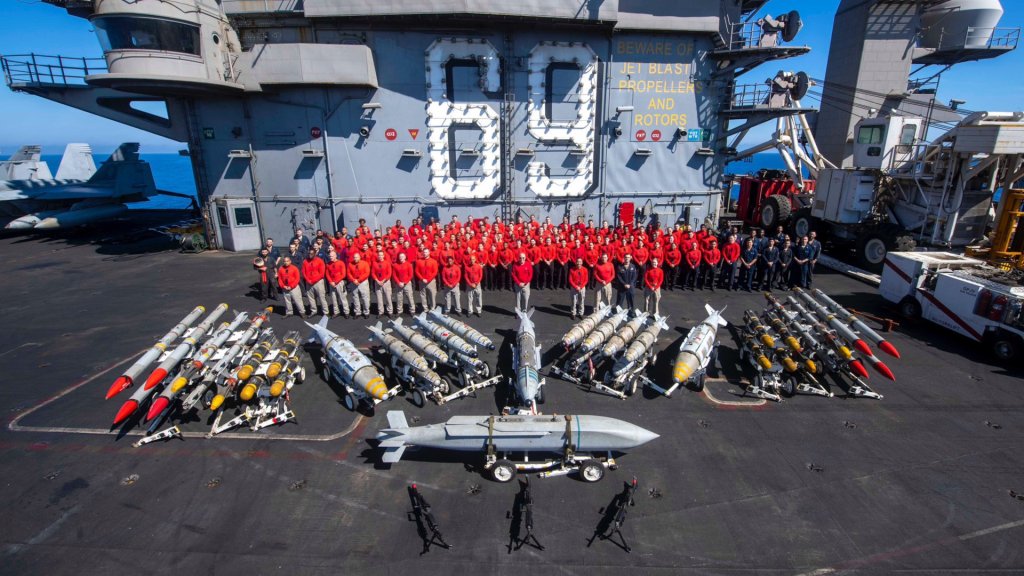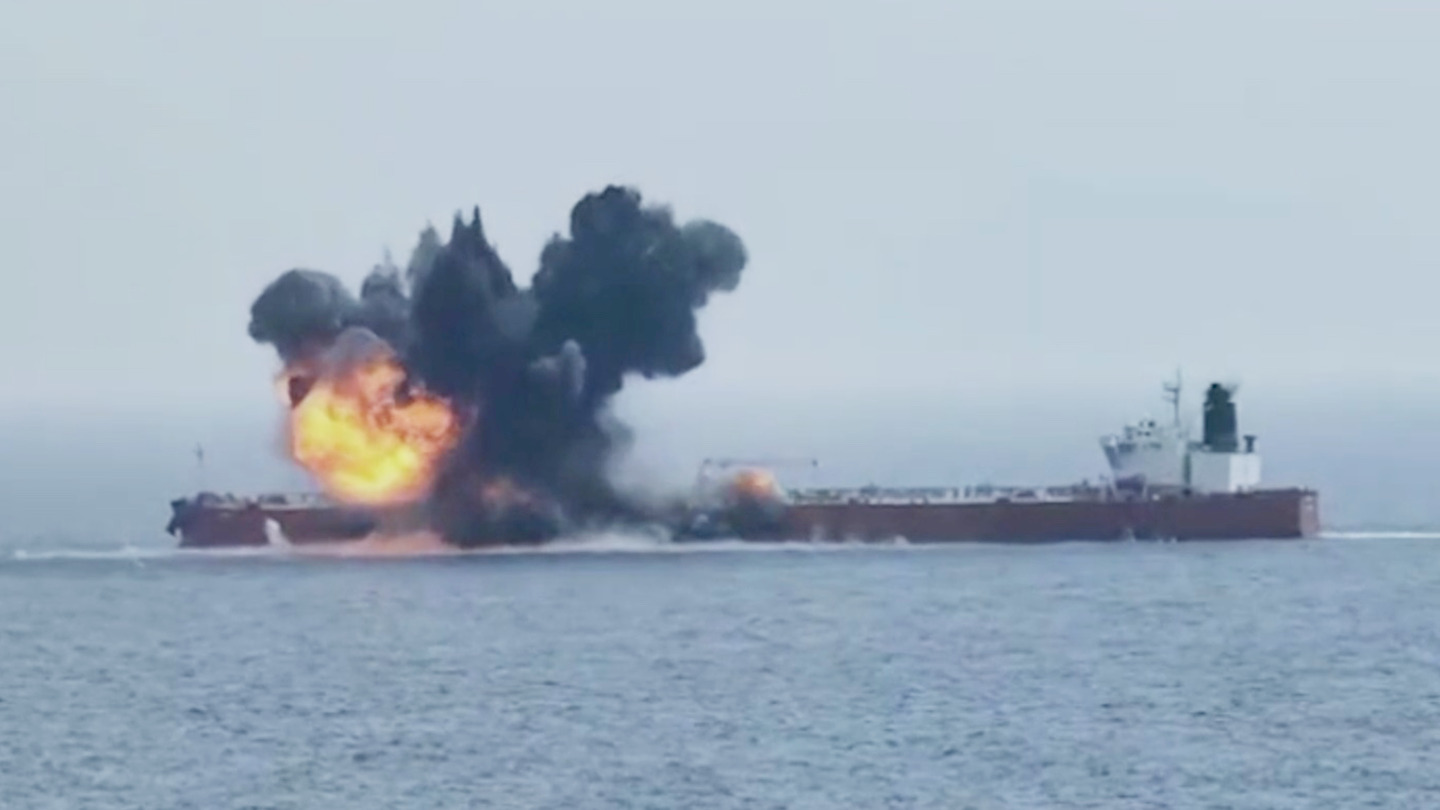During its nine-month deployment to the Middle East, the USS Dwight D Eisenhower carrier strike group (IKECSG) fired off nearly 800 munitions fending off attacks on its ships and commercial vessels from the Houthis. Now a new report claims Russia gave the Yemeni rebel group targeting data in large measure to keep the U.S. entangled in the region and draw resources and attention away from Moscow’s grinding war in Ukraine.
The Houthis began attacking shipping in October of 2023 in support of Gaza and “eventually began using Russian satellite data as they expanded their strikes,” The Wall Street Journal reported on Thursday. The publication cited “a person familiar with the matter and two European defense officials.”
The data “was passed through members of Iran’s Islamic Revolutionary Guard Corps (IRGC), who were embedded with the Houthis in Yemen,” one of the people told the Journal.
There is no indication in the Wall Street Journal’s report exactly when the data was supplied or if it contributed to any of the successful attacks on shipping. Regardless, the publication said it highlighted Russian President Vladimir Putin’s interest in undermining what the Pentagon keeps referring to as the U.S.-led “rules-based order.”
Responding to discussions about the U.S. and allies allowing Ukraine to strike deep into Russia with its donated weaponry, Putin threatened to send long-range weapons and military support to “regions” around the world where they could be used for strikes against Western targets.
“For Russia, any flare-up anywhere is good news, because it takes the world’s attention further away from Ukraine,” Alexander Gabuev, director of Carnegie Russia Eurasia Center, a think tank based in Berlin, told WSJ.
Houthi attacks on shipping sucked up a lot of U.S. and allied resources. In addition to the IKECSG’s ships and aircraft, several other American and allied sea and air assets took part in defending shipping. They swatted away missiles and drones and blew up uncrewed surface vessels. They also attacked Houthi targets in Yemen. As we reported last week, B-2 Spirit stealth bombers, along with other U.S. forces, conducted a strike on Houthi underground weapon storage sites in Yemen. Land-based aircraft and other assets also took part in the fight.
Navy Secretary Carlos Del Toro disclosed at a Congressional hearing in April that his service alone had already expended at least $1 billion worth of munitions in operations against the Houthis since October 2023 and in the defense of Israel that month. The Navy was reported to have hit the 100 Standard Missiles fired mark by February of this year.

There were also two international task forces created to defend Red Sea region shipping. The U.S.-led Operation Prosperity Guardian, which The War Zone was the first to write about, was stood up last December. The European-led Operation Aspides launched two months later.
Despite all these assets deployed to the region, the Houthis kept up their attacks. Since launching this campaign a year ago, the militants attacked more than 100 ships, sinking two, damaging others, and hijacking another, the Journal noted. The following video shows the November 2023 Houthi hijacking of the Bahamian-flagged Galaxy Leader.
Those attacks disrupted global shipping, forcing companies to shift from passing through the Suez Canal to taking much longer, and more expensive routes around the Cape of Good Hope on the southern tip of Africa.
“Almost 1-in-10 barrels of oil shipped every day worldwide transit through Bab al-Mandab, the strait that separates the Red Sea from the Indian Ocean,” the Journal noted. “The tanker traffic through that route was 77% lower in August 2024 compared with October 2023, according to Windward, a maritime-intelligence company.”
Russian oil tankers have been hit by the Houthis as well, but they are part of a “ghost fleet” created to circumvent international sanctions.
Concerns about Russian assistance to the Houthis go beyond providing targeting data.
The U.S. has been worried that Russia could further exacerbate the situation by providing the Houthis with its anti-ship or anti-air missiles as well as other weapons. Those arms could hinder efforts to protect shipping and place U.S. and allied forces at greater risk. However, there is no evidence that such transactions have occurred. Such a move would provide a huge boost to the large arsenal of anti-ship missiles already possessed by the Houthis, who became the first in the world to fire anti-ship ballistic missiles in anger.
In addition to helping the Houthis, Russia may also be aiding Hezbollah in its fight against Israel.
Last week, Israeli Prime Minister Benjamin Netanyahu said that Israeli forces had found “state-of-the-art” Russian weapons in searches of Hezbollah bases in south Lebanon. However, those weapons could also have been transferred by Iran or obtained by other means. Some of those weapons are on display in the following video.
That Russia would help the Houthis strike warships and commercial vessels in the Red Sea to divert resources and international attention away from its Ukraine fight further highlights how closely the conflicts in Europe and the Middle East are intertwined.
We reached out to the National Security Council and the Pentagon for comment about the claim that Russia provided the Houthis with targeting data and if so, what they might do in response. We will update this story with any pertinent information provided.
Contact the author: howard@thewarzone.com
